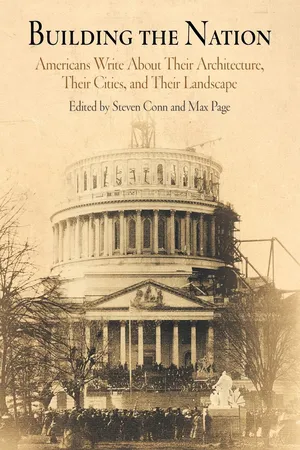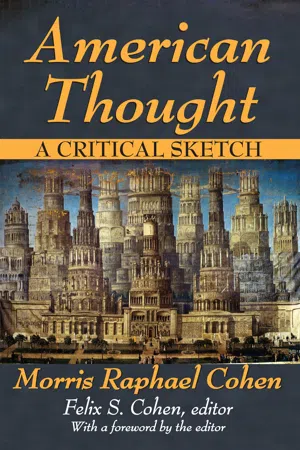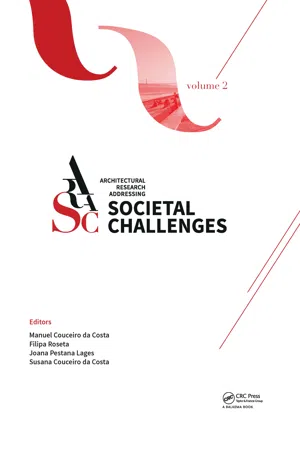History
American Architecture
American architecture encompasses a diverse range of styles and influences, reflecting the country's history and cultural diversity. From colonial and neoclassical designs to modernist and postmodernist structures, American architecture has evolved over time, incorporating elements from various periods and regions. Notable examples include the skyscrapers of New York City, the colonial buildings of New England, and the mid-century modern homes of California.
Written by Perlego with AI-assistance
Related key terms
4 Key excerpts on "American Architecture"
- eBook - ePub
Building the Nation
Americans Write About Their Architecture, Their Cities, and Their Landscape
- Steven Conn, Max Page(Authors)
- 2016(Publication Date)
- University of Pennsylvania Press(Publisher)
The Beer Can by the Highway . What Kouwenhoven noticed about Americans was our fascination with speed, with force and with motion. In this piece, he sees an American Architecture embodied in, among other things, vernacular designs that express structural tensions and competing forces.We may ask what is “American” in architecture and design because we want to establish their continuity with buildings and objects of the past. And if this is our motive in asking the question we will, of course, be most interested in those buildings and objects whose structure and aesthetic effect are clearly related to, and thus comparable with, those of their predecessors in the Western tradition. We will concern ourselves, that is, with architecture in its textbook sense, as a fine art which has developed continuously, with local and national variants, throughout the Western world.If we approach the question in this way, taking “architecture” to mean churches, government buildings, and palaces (for princes or merchants), and taking “design” to include what the nineteenth century lumped as “Industrial Art” (manufactured objects to which one could apply “arts and crafts” decoration, such as pottery, textiles, bijouterie, and the printed page), we will probably conclude that the “American” quality is catholicity. We can find in the United States an imitation of almost any architectural style or decorative mannerism which ever existed in any other nation. And when we have done so, all we shall have demonstrated is what we already knew: that Americans came from everywhere, and brought with them the traditions—architectural and decorative as well as social and religious—of which they were the heirs. We shall have learned what is English or Spanish or German about our architecture and our design, and therefore how they relate to the Western tradition; but we shall know as little as ever about their “American” quality, if such there be. . . . - Clare Cardinal-Pett(Author)
- 2015(Publication Date)
- Routledge(Publisher)
The neoclassical facade preserved the arcaded loggia typical of Spanish-American cabildos everywhere. The use of the Tuscan order on the street level of the pedimented entry is probably the Italian architect’s taste. The Ionic detailing of the upper story shows French neoclassical influence. In 1821 the Spanish colonial ornament in the pediment was replaced with an eagle. 42 The mansard third story with baroque dormers added in 1847 makes the overall composition an awkward creole collage. The New Orleans City Council continued to meet in the Sala Capitular until the 1850s when a new American Greek revival city hall designed by James Gallier (an Irish immigrant) relocated the city’s political center—upriver from the creole parts of town in the rapidly expanding “Anglo” neighborhoods along St. Charles Avenue (Figure 6.26b). The Houses of Ordinary Folks The monuments of church and state that occupied prominent places in American cities at the beginning of the 19th Century compose an interesting record of stylistic appropriation and invention that occurred during the colonial period. The first attempts to use civic buildings as symbols of independent national identity in the USA inspired others elsewhere to search the history of architecture for elements that might suit similar efforts to invent new traditions. The range of house types among the diverse ethnic groups who called themselves Americans in 1800 is another sort of lens through which the built environment might be studied. Worldwide, dwellings have always formed the vast majority of the built environment and as such both define and reflect how we live and who we are at the most fundamental level. However anonymous, patterns of everyday life provide the basic framework for all aspects of human culture- eBook - ePub
American Thought
A Critical Sketch
- Morris Cohen(Author)
- 2017(Publication Date)
- Routledge(Publisher)
de novo, on virgin soil, within a relatively short historical period, but nowhere else are structures so readily torn down to make room for new ones. Nor have our architects been devoid either of native ingenuity or of adequate professional training. The curricula of their professional schools have been highly commended and used as models abroad. Nor has American ingenuity and practical resourcefulness been anywhere more marked than in the way it has met the great diversity of needs and problems set by modern materials, engineering methods, and the practical demands of homes, offices, railroad stations, hospitals, and the like.Europeans, as well as the Japanese, have not only copied our methods of construction, but they have actually sent for our architects to design their hotels and apartment houses. At least one American, Frank Lloyd Wright, has become a major prophet of the new art in Germany, Holland, and elsewhere; while it would be difficult to name any building of the past century much superior in point of sheer beauty to some of those produced by Henry H. Richardson or Bertram G. Goodhue. Yet, in the field of reflective thought, we have brought forth nothing comparable to the work of men like Ruskin or Le Due, nor even Geoffrey Scott’s Architecture of Humanism . Whatever the cause of this seemingly national disinclination or ineptitude for general reflection, which was already noted by DeTocqueville, only ignorance or wilful blindness would dismiss as utterly worthless what America has contributed in this field.In architecture, as in every other phase of American cultural life, the effects of the Civil War were thoroughly devastating. The ensuing era of Western expansion, railroad building, and the general mobility of that time, caused our people to look upon ordinary buildings as temporary devices. Taste was determined largely by nouveaux riches, who cared more for lavish expenditure than for the sources of permanent satisfaction.Into this scene came a band of courageous pioneers trained in the Beaux Arts - eBook - ePub
Architectural Research Addressing Societal Challenges Volume 2
Proceedings of the EAAE ARCC 10th International Conference (EAAE ARCC 2016), 15-18 June 2016, Lisbon, Portugal
- Manuel Jorge Rodrigues Couceiro da Costa, Filipa Roseta, Susana Couceiro da Costa, Joana Pestana Lages(Authors)
- 2017(Publication Date)
- CRC Press(Publisher)
Fig. 1 ), the issues of preservation of historical heritage, debated for over two centuries in Europe, have been addressed over time in different ways. In a country characterized by a strong spirit of innovation and given the dominant position of economics in public and private choices, the transformation of the building heritage had less to do with scrupulous attitudes than in the Old World. Nevertheless recently we can notice a growing awareness, demonstrated by greater integration between environmental protection and urban planning (Mugayar Kühl 2007: 139), also in terms of sustainable development (Stubbs & Makaš 2011: 473–74). We can clearly see that the results of preservation are strongly conditioned by the intense connection between the private and public sectors (Rosina & Corbin Murphy 2002: 55).Reflections on architectural history and on historical heritage preservation were at a crucial point in the 1960’s and 1970’s, also illustrated by the birth of the National Historic Preservation Act in 1966 and the successive territorial conservation registers and commissions (Longstreth 1999: 326). During this period scholars and American professionals looked at the European experiences (Figs. 2–3), as demonstrated by the Getty Conservation Institute’s effort to publicize European ideas in the USA (Mugayar Kühl 2007: 139).With regards to the different context and architecture, attitudes differ: in America, aspects like national identification, symbolism and historical narration, as well as economic interest are more important than the authenticity or the historical value of the building. In American culture a restored and preserved building has no intrinsic value as layering of history, and it is ‘disconnected’ from the flow of time. Architecture is seen “as a tool for illustrating history” (Fiorani 2013: 17); at the same time, a historical building which does not have a symbolic and patriotic value, is susceptible to transformation, replacement or demolition.American thought has long been influenced by a rigid idea of preservation, basing the classification and evaluation of cultural heritage only on style, function and symbolism. Nevertheless, it should be pointed out that recently a new focus on the issue of preservation of existing buildings is emerging. Indeed, “today increasing numbers of high-caliber students in doctoral as well as master’s programs are giving serious consideration to the field” (Longstreth 1999: 332). The recent awareness in dealing with the theme of preservation and restoration is indeed evident in the university programs of the main American schools of architecture, analysis of which highlights how students are faced with the issues of authenticity and testimonial value of historical heritage, with a more critical attitude towards preserving historical buildings than in the past.
Learn about this page
Index pages curate the most relevant extracts from our library of academic textbooks. They’ve been created using an in-house natural language model (NLM), each adding context and meaning to key research topics.



